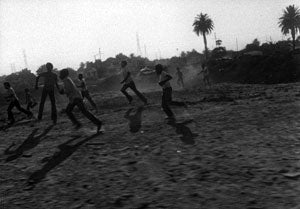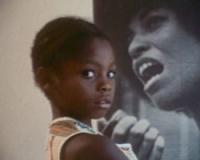While the adults in the impoverished neighborhood of Charles Burnett’s Killer of Sheep labor and toil and steal and plot, the children play. They play in dangerous alleys and streets, they play war in urban wastelands, and they leap fearlessly from rooftop to rooftop, completely unaware of their poverty and dire situation. And, while the children play, the parents suffer and as a result the children suffer too. This is the heart of Killer of Sheep: how children learn and internalize grown-up behavior and duties from the adults in their world.
With a particular sympathy for the children, Killer of Sheep is a plot-free, yet carefully drafted dramatic black and white film. It reflects the routine lives of a family combined with random and often absurd events. Blending the harsh reality of the ghetto in Black Los Angeles Watts in the mid-1970s with observant surrealism, the film unfolds as a series of interludes involving the family’s children, the parents, friends and strangers who pass through their lives.

The father, Stan (Henry Gayle Sanders), works in a slaughterhouse, literally a killer of sheep, while his wife (Kaycee Moore) struggles to get her distant husband to connect emotionally and physically. The family’s two children, Stan Jr. and Angela, (played by Jack Drummond and Mr. Burnett’s niece, Angela), are ever present, but like the adults, are disconnected and often wander alone. Growing up in an environment eerily similar to this one, I connected the sheep in the factory to the children and how they both are forced to watch their families die, literally, before their eyes, completely unaware that their own deaths are imminent.
In the memorable opening scene, a father harshly berates his eldest son (the childhood Stan) for not defending his younger brother in a fight. He tells the boy that it doesn’t matter if his sibling was wrong or right, but that he should have protected him because they are family and therefore all they have. The boy’s mother, who has been soothing the crying brother, walks up with an almost “Mona Lisa” smile on her face and, without a word, smacks the elder son across face. A slap worthy of crying on many levels, yet, the boy doesn’t shed a tear. He takes this assault just like the verbal tongue-lashing, not as a child, but as an adult.
What’s interesting is that Killer of Sheep doesn’t ask us to feel sorry for the adults or children in this world, but to see them, hear them and acknowledge their existence. In one of the films most powerful scenes, Angela, wearing a grotesque rubber dog mask, stands silently while her father works on a house project with a friend. A silent observer in the room, the men seem to not notice her until her Stan Jr. comes in and, in a forceful way, demands that she take it off. Surreal moments like this serve to underscore the absurdities of everyday life and the concurrent resilience of humanity in the face of the dehumanizing forces acting on poor communities.
Declared a “national treasure” by the Library of Congress and one of the "100 Essential Films" of all time by the National Society of Film Critics Killer of Sheep is truly an American masterpiece.
—Michelle Amor






 Mobile Navigation
Mobile Navigation

